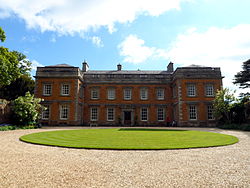Farnborough Hall: Difference between revisions
Created page with '{{Infobox NT |name=Farnborough Hall |county=Warwickshire |picture=Farnborough Hall North.jpg |picture caption=Farnborough Hall, north side and main entrance |os grid ref=SP4349 |…' |
mNo edit summary |
||
| Line 5: | Line 5: | ||
|picture caption=Farnborough Hall, north side and main entrance | |picture caption=Farnborough Hall, north side and main entrance | ||
|os grid ref=SP4349 | |os grid ref=SP4349 | ||
|type=Country house | |||
|website={{NT link}} | |website={{NT link}} | ||
}} | }} | ||
Latest revision as of 14:37, 26 July 2015
| Farnborough Hall | |
|
National Trust | |
|---|---|
 Farnborough Hall, north side and main entrance | |
| Grid reference: | SP4349 |
| Information | |
| Website: | Farnborough Hall |
Farnborough Hall is a country house in Warwickshire just inside the county’s boundary with Oxfordshire, across which is its closest town, Banbury. The property has been owned by the National Trust since 1960 when the Holbech family endowed it to them, though the house is still run and lived in by Geoffrey Holbech's daughter Caroline Beddall.
It is a Grade I[1] listed building.
The Holbech family acquired the Farnborough estate in 1684 and the honey-coloured two-storey stone house was built soon after.
Major changes to the property occurred between 1745 and 1750 when the entrance front was remodelled and the rococo plasterwork was added to the interior. This work was carried out by William Holbech who wanted a suitable setting for the sculpture and art he had brought back from his Grand Tour. He most likely used designs by his close friend Sanderson Miller, an architect, who lived a few miles away. Long Palladian facades with sash windows, pedimented doorways and a balustrated roofline were added to the earlier classical west front.
Unlike many of its contemporaries, Farnborough Hall and its landscaped gardens have experienced little alteration in the last 200 years and they remain largely as William Holbech left them.
The entrance opens straight into the Italianate hall. The walls are adorned with busts of Roman emperors set into oval niches and the panelled ceiling is stuccoed with rococo motifs. The dining room on the south front was especially designed to display works by Canaletto and Giovanni Paolo Panini. The original works are long gone, being replaced by copies. The drawing room has panels of elaborate stuccowork featuring scrolls, shells, fruit and flowers; these serve as a framework for more Italian works of art. A stucco garland of fruit and flowers encircles the skylight above the staircase hall.
Gardens
In the mid 18th century the gardens were significantly enhanced by Sanderson Miller to dramatic effect. The land at the front of the Hall slopes downward to give a view of lake below. To the left of the house a grassy Terrace Walk is flanked by trees and excellent views of the Warwickshire plain can be had from here. The terrace leads past an Ionic temple and an oval pavilion, which has two storeys and elaborate plasterwork, to an obelisk at the end of the walk.
-
West side
-
West side
-
South side
-
Ionic Temple
-
Oval Pavilion
-
Game Larder
-
Obelisk
-
Rose Garden
-
Rose Garden
Outside links
- Farnborough Hall at the National Trust








